Inside the quest to keep homeless people safe in Fort Worth’s deadly summer heat
Fatimah Robinson dragged an Igloo cooler full of cold water bottles behind her, headed toward a neighborhood of tents in a partially wooded area near the Historic Southside neighborhood of Fort Worth.
She was looking for Gary Randle, the man she affectionately calls her twin because of their similar personalities.
“Twin! Twiii-in!” Robinson yelled. The cooler occasionally bumped on large stones or tree roots as Robinson pulled it down a worn path to a campsite, where several tents are clustered together. Clean laundry hangs on a line outside of one tent; it had just been washed in the nearby creek. A small fire burns outside another. The camp is home to about six homeless people, including Randle.
Their campsite is off of U.S. 287, but the brush surrounding the site insulates it from the noise of speeding cars. The campsite isn’t visible from the highway, and you could probably only find it if you knew exactly where to look. And Robinson does.
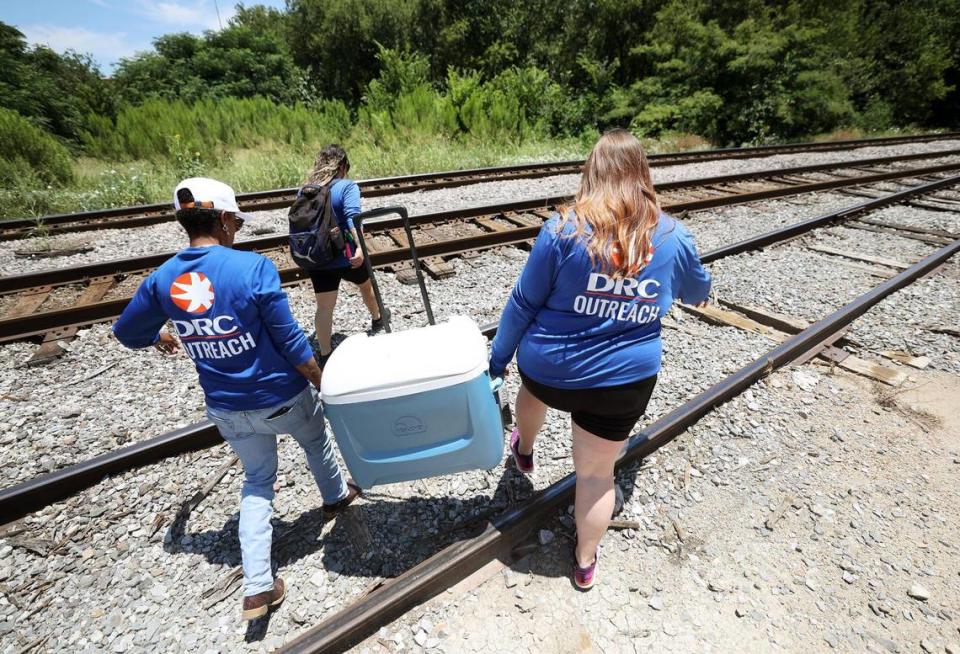
As Robinson approaches, Randle spots her and runs toward her to give her a hug. He takes a few bottles of water from the cooler. On that Friday, the temperature is cooler than it’s been all week: It’s 99, after eight consecutive days of heat index values in the triple digits.
Randle is one of about 400 homeless people Robinson and her colleagues at DRC Solutions check on each month. The Fort Worth nonprofit works primarily with homeless people who are unsheltered, meaning they don’t live in homeless shelters or on a friend’s couch. Many of them, like Randle, build campsites tucked in corners of Fort Worth that are out of the public eye and away from the code enforcement complaints that such visibility usually brings.
The DRC team works with its clients to get them into permanent housing. In the summer, an extra challenge is added: Workers need to make sure the hundreds of people living outside stay safe from the deadly temperatures of Texas summer.
Deaths in extreme heat
There is no nationwide tally for how many homeless people die from extreme heat each year, but a growing body of research indicates that people who live outside are at greater risk for climate extremes than those with permanent, safe homes.
June’s heatwave descended on hundreds of people in Fort Worth who live outside. The Tarrant County Homeless Coalition estimates that there are more than 1,000 people living on the streets, in the woods, or in other outdoor communities in Tarrant and Parker counties, according to its most recent report. The number of homeless people has increased significantly in the last two years, as renter protections and additional funding from the first two years of the COVID-19 pandemic expired and were used up.
Now, the nation’s persistent housing crisis coupled with increasingly hot summers has left the most vulnerable, including the unhoused, at particular risk for getting sick from or dying from the heat.
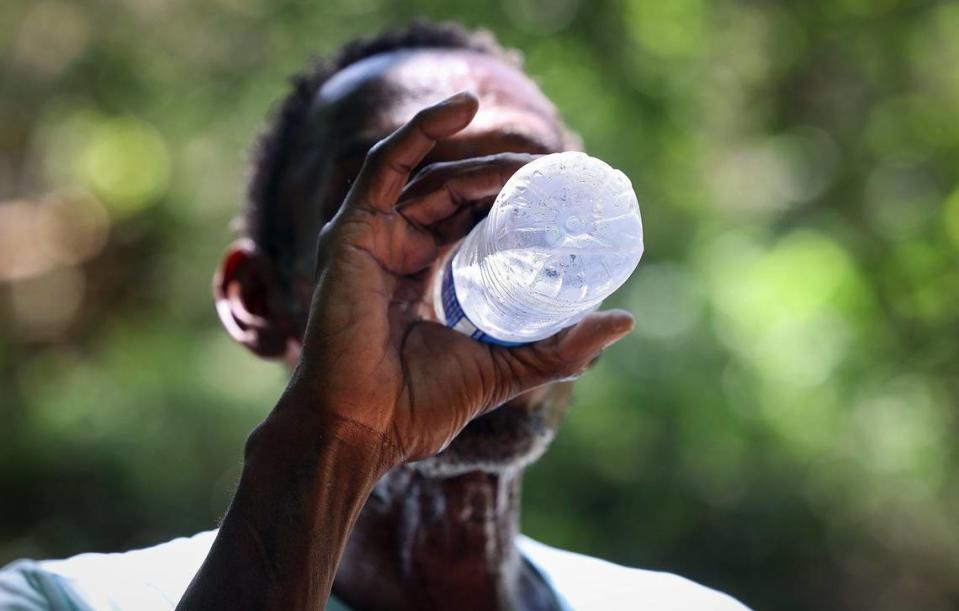
There’s no exact tally in Tarrant County for how many homeless people have died from or been hospitalized because of extreme heat. Analyses from previous years show that heart disease is the leading cause of death for people experiencing homelessness, said Lauren King, the executive director of the Tarrant County Homeless Coalition. King said that, anecdotally, more people living outside had died from extreme cold temperatures that very hot ones.
But in the handful of cities and counties that are tracking the weather-related deaths among people who are homeless, the risk of extreme heat is clear. In Clark County, Nevada, home to Las Vegas, an analysis by the Las Vegas Review-Journal found that people experiencing homelessness made up a third of all deaths related to extreme heat in 2021. In Los Angeles County, people without homes made up almost half — five in 12 — of every death from heat-related illness or exposure in 2022, according to the county coroner’s office.
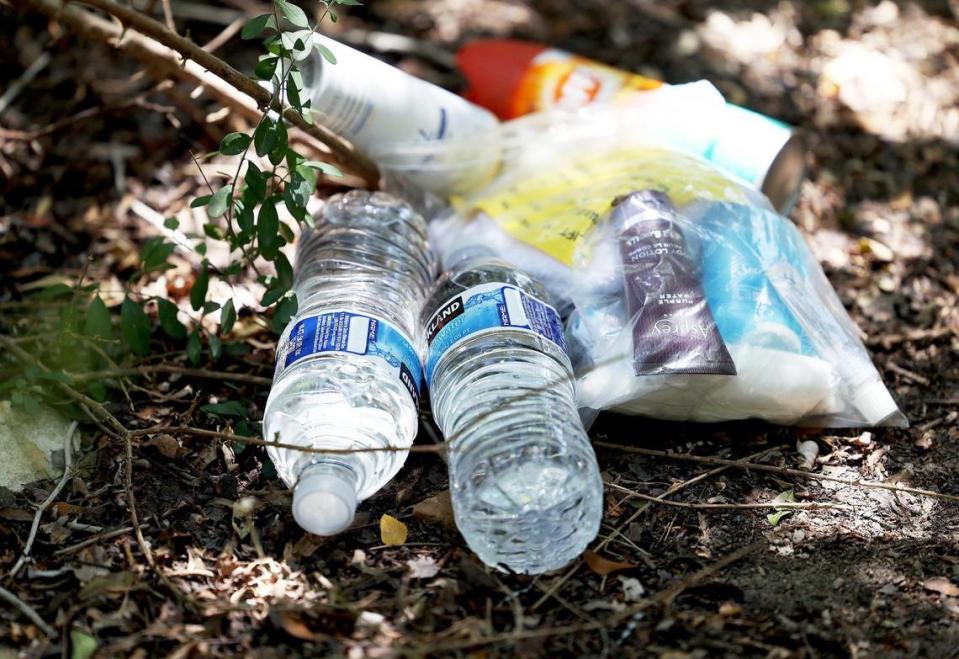
“There’s been increasingly alarming statistics … suggesting that a large number of the deaths that do occur during heatwaves or extreme heat are are among people who are experiencing homelessness,” said Dr. Sameed Khatana, a cardiologist and professor at the University of Pennsylvania’s medical school.
Homeless people have greater exposure to hot temperatures plus fewer opportunities to give their bodies a break to cool down, Khatana said, but they also have a higher rate of cardiovascular disease, putting them at greater risk for the stressors that heat places on the heart. Most people who die from heat don’t suffer from hyperthermia, where the body’s core temperature gets so hot that it causes the body to fail. Instead, Khatana’s research has found that most of the unexpected deaths that happen after an abnormally hot day are caused by heart failure.
Randle, 61, guesses that he’s passed out from heat multiple times over his years living outside. When he feels like he’s having a hard time breathing, he’ll go and sit in the creek that runs next to his tent. His neighbors know that if they don’t see him up and about his campsite, they should go and check on him to make sure he’s OK.
“It’s just killer,” Randle said. “It’s hard for me to breathe some days. When I feel like that I just get in the water and try to calm myself down.”
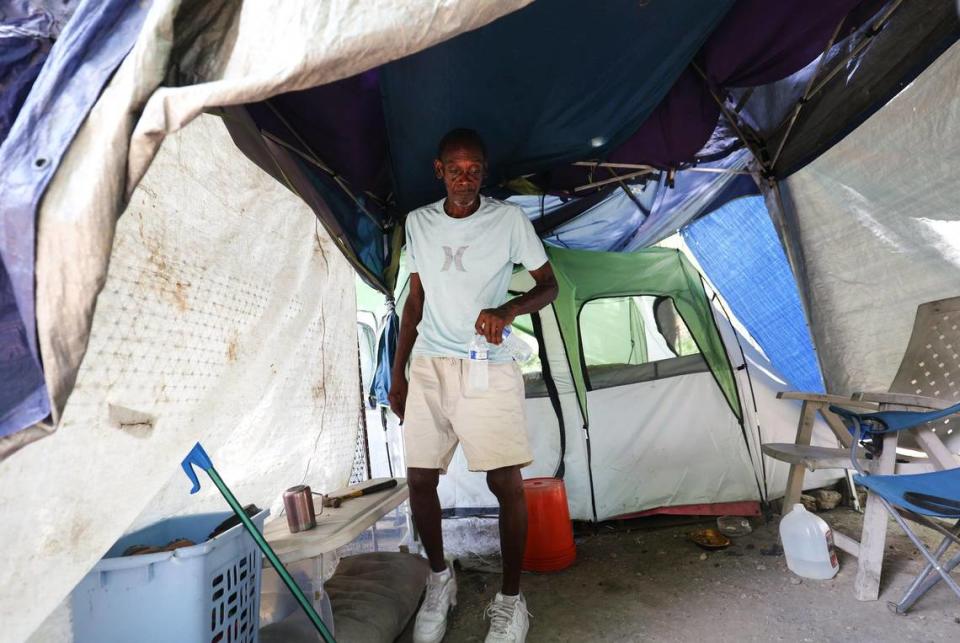
Life on the streets
DRC, formerly known as the Day Resource Center, focuses its work on a group of homeless people who have historically been among the hardest to reach in Fort Worth: The unsheltered. This group historically has represented a smaller share of people without housing in Tarrant County, compared to those who stay in emergency shelters. The majority of people experiencing homelessness in the county do so for less than a year, according to data from the homeless coalition. But for others, they might experience life on the streets for much longer.
For some people, living outside is a personal preference, allowing them to bypass the rules and regulations of life in a shelter. Some people say they avoid the shelters because they don’t like crowds, or because they prefer the freedom of making their own schedule and building their own community. For others, there is no other choice: Fort Worth’s overnight shelters have sometimes been at capacity over the last two years as more and more people have been pushed into homelessness.
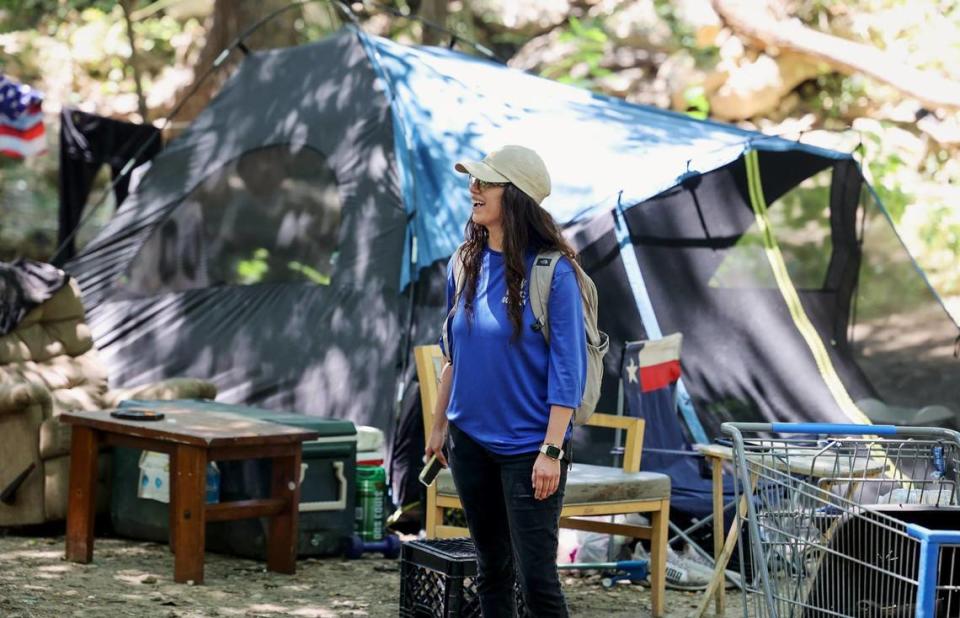
On a recent Thursday, the DRC’s outreach team started its day by bringing a man who had been living on the streets to the Greyhound Bus Station in downtown Fort Worth. He was about to start a 36-hour journey to Toledo, Ohio, where his son lives and had agreed to take him. If a bus ticket can get someone safely to a friend or family member in another city, DRC outreach workers will always give someone that option. But not everyone has loved ones they can turn to for shelter, outreach team lead Johnetta Hudspeth said.
Next, the team drives to a campsite in east Fort Worth. After navigating through the bushes and trees that surround the campsite, Hudspeth and her colleagues find about a dozen people living here, more than the last time they visited. The campsite has grown.
Hudspeth talks with one man who was recently released from jail, and is suffering from opioid use disorder. He tells Hudspeth that he and some others at the campsite are using fentanyl, the synthetic opioid that can easily cause fatal overdoses. Robinson runs back to the van to get narcan, the life-saving drug that can reverse an opioid overdose when sprayed in the nostrils.
Next, a young woman checks in with Jordan Autry, another outreach worker, about her persistent asthma. It’s been harder for her to breathe lately, she tells Autry. Autry tells her that that the street medicine team run by JPS Health Network will be by the camp later that day to help her.
Like Randle’s camp near downtown Fort Worth, this campsite has its own routines and rhythms that residents follow to keep themselves safe.
Nathan Barrett, 37, has been living outside for about a year. For him, summers aren’t quite as bad for the winters. Barrett has found that key to living outside is adapting, and learning to be creative with the tools you have. He and his neighbors have adapted by using a box fan plugged to a generator, a cooler full of ice, and some tubing to funnel cold air into their tents.
“We try to keep big thermoses with us at all times, so that we always have water on hand,” he said.

The DRC’s street outreach team spends all of its days like this: Going from community to community, looking for old and new clients alike, and trying to respond to their needs as quickly as realistically as possible. The outreach teams check on their clients at least once a month, helping them with any immediate needs they have, but also trying to give each person a shot at a permanent home. For many adults, that means starting with their essential documents: Their birth certificates, their Social Security cards, and other forms that can prove their identity but that often get lost in years living on the streets and moving from place to place. Once all the paperwork is in order, a waiting game begins, sometimes for months, sometimes for years.
The Tarrant County Homeless Coalition operates system that matches residents who are homeless with programs that can help pay for their housing and apartments that will rent to them.
Most of the people DRC works with are waiting to qualify for the permanent supportive housing program, which offers indefinite rental support, or one of the other housing assistance programs.
On a recent Thursday, outreach worker Jordan Autry drives to a small campsite in Fort Worth with some good news: Her client Maxine Owens is off the housing waitlist, and has been matched with an assistance program that will help Owens pay her rent for at least three months. After that, Owens will have to find another way to pay rent. But for three months, she’ll get a break from the summer heat and living outside.
Owens responds to the noise with a shout of joy and a dance. She are her two dogs are moving from a a tent to an apartment.
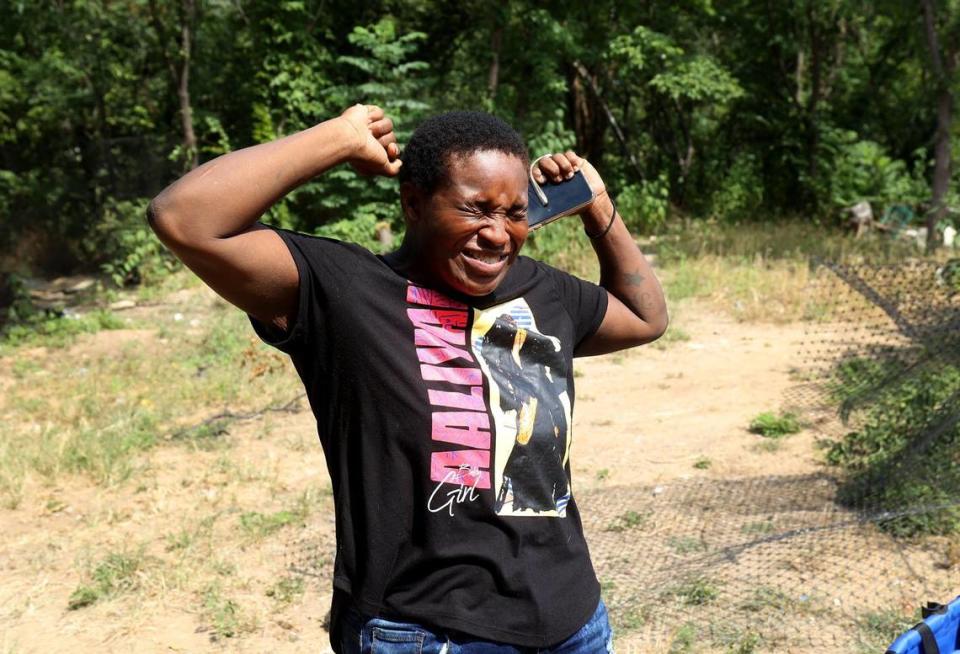
“After this long journey of fighting, I was able to get the help that I’ve been asking for,” she said.
Owens, 32, said she’s looking forwarding to having a place of her own. But mostly, she said, she’s looking forward to having air conditioning.
“If they come over to visit or come by to see me, they’re going to feel like they’re walking into the Arctic air,” Owens said, laughing. “There is no touching or turning my air off. I am going to freeze everybody.”


 Yahoo Autos
Yahoo Autos 